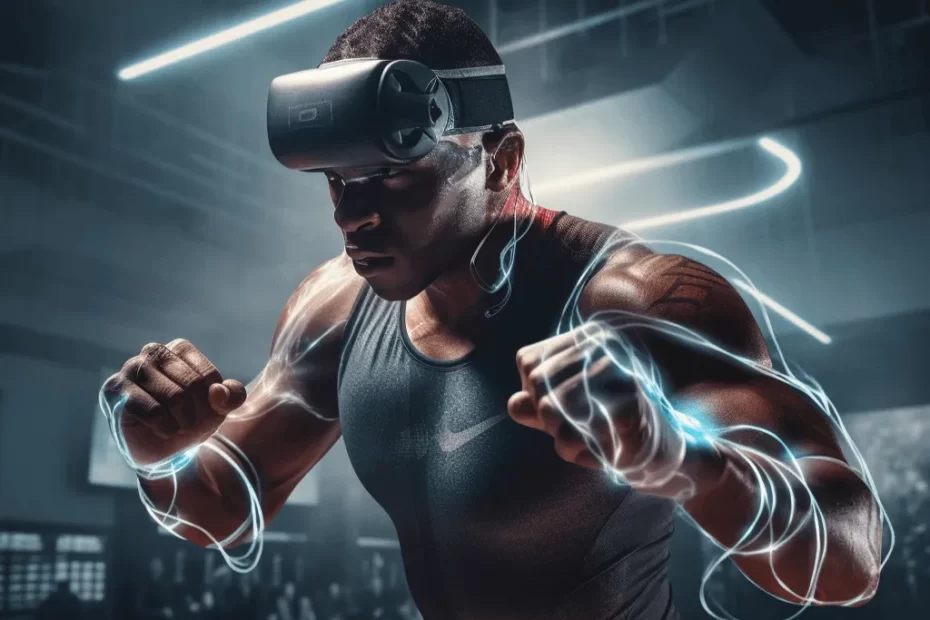In recent years, virtual reality (VR) has emerged as a groundbreaking tool in the sports industry, transforming how athletes train, how fans engage, and how coaches plan their strategies. This article explores the profound impact of VR on sports training, examining its benefits, current applications, and future potential. For athletes and sports organizations aiming to stay ahead of the curve, understanding the role of VR in sports is essential. This article delves into how VR offers immersive experiences that are changing the way sports training is conducted, making it a must-read for anyone interested in the future of sports.
What is Virtual Reality and How is it Used in Sports?
Virtual reality is an immersive technology that creates a simulated environment, allowing users to interact with 3D worlds using VR headsets. In the sports industry, VR has found diverse applications, from enhancing sports training to revolutionizing fan experiences. Using virtual reality in sports, athletes can engage in immersive training environments that replicate real-world scenarios, enabling them to refine their skills in a controlled setting. VR technology has also been integrated into various aspects of sports, offering innovative solutions that extend beyond traditional training methods.
The use of VR in sports is not just a trend but a significant advancement in how athletes prepare and perform. By offering simulations of game situations, VR allows athletes to practice and improve their techniques without the risks associated with real-world sports. This integration of virtual reality for sports is particularly beneficial in contact sports like American football, where injury prevention is crucial.
How Does VR Enhance Traditional Sports Training Methods?
Traditional sports training methods have long been the foundation of athletic preparation, focusing on physical conditioning, technique refinement, and strategic planning. However, virtual reality is changing the way sports training is conducted by introducing new dimensions of interactivity and precision. VR sports training allows athletes to engage in repetitive training exercises that can be tailored to specific needs, helping them to refine their skills with unparalleled accuracy.
One of the key advantages of using VR in sports training is the ability to simulate real-world scenarios that would be difficult or impossible to replicate in traditional settings. For instance, VR simulations can help athletes prepare for high-pressure game situations, enabling them to develop the mental resilience needed for peak performance. Moreover, virtual reality offers an immersive experience that enhances the cognitive aspects of sports training, making it possible for athletes to visualize and execute complex plays with greater confidence.
Examples of VR in Sports Training: From Football to Tennis
The application of VR in sports training spans a wide range of disciplines, from football to tennis. In American football, VR is used to simulate game situations, allowing players to practice their responses to different scenarios without physical contact. This not only helps in skill development but also in reducing the risk of injuries during practice. Tennis players, too, have found virtual reality training beneficial in refining their techniques, particularly in areas such as footwork and shot accuracy.
Virtual reality sports training is also being embraced by professional teams across the globe. For instance, VR technology is used to create detailed simulations of opponents’ strategies, giving athletes a competitive edge in preparation for major sporting events like the World Cup or the Olympic Games. By incorporating VR into their training regimes, athletes can achieve a level of preparedness that was previously unattainable with traditional methods.
The Impact of VR on Athletes: Enhancing Skills and Performance
Virtual reality has a profound impact on athletes, particularly in enhancing their skills and overall performance. VR training allows athletes to immerse themselves in a virtual environment where they can repeatedly practice specific drills, such as shooting hoops in basketball or perfecting a serve in tennis. This repetition in a controlled, immersive environment leads to muscle memory development, which is crucial for high-level performance.
Moreover, VR facilitates the integration of sports science into training programs, allowing for the analysis of an athlete’s performance in real-time. Coaches and athletes can use this data to make informed decisions about training adjustments, ultimately leading to improved performance. The immersive nature of VR training also helps in mental conditioning, as athletes can visualize themselves in competitive scenarios, building the psychological resilience needed to succeed under pressure.
Virtual Reality in Sports: The Role of VR in Injury Prevention and Rehabilitation
One of the significant benefits of virtual reality in sports is its role in injury prevention and rehabilitation. VR simulations can replicate the physical demands of sports without the associated risks, allowing athletes to train in a safe environment. For example, VR sports training can be tailored to gradually increase the intensity of exercises, helping athletes to build strength and endurance while minimizing the risk of overtraining.
In the context of rehabilitation, VR offers an innovative approach to recovery. Athletes recovering from injuries can engage in rehabilitation exercises within a virtual environment, which can be adjusted to their specific needs. This not only helps in physical recovery but also in maintaining mental focus and motivation during the rehabilitation process. Virtual reality training can simulate the movements required in their sport, allowing them to regain confidence in their abilities before returning to real-world competition.
How VR is Changing the Way Coaches and Athletes Prepare for Competitions
The integration of VR in sports training is transforming the way coaches and athletes prepare for competitions. With virtual reality technology, coaches can create highly detailed simulations of opponents’ tactics, giving athletes a unique opportunity to study and counter strategies before facing them in real life. This level of preparation is particularly valuable in sports where strategic planning plays a crucial role, such as soccer or basketball.
Additionally, VR training allows coaches to monitor athletes’ performance during virtual training sessions, providing instant feedback and making necessary adjustments on the spot. This interactive and immersive training method helps athletes to refine their techniques and game plans more efficiently than traditional training methods. The nature of VR, with its ability to recreate specific game situations, ensures that athletes are better prepared mentally and physically when it comes time to compete.
VR’s Role in Fan Experience: A New Way of Watching the Game
While VR has primarily been focused on enhancing athletes’ performance, its impact on fan experience is equally significant. Virtual reality offers fans an immersive experience that brings them closer to the action than ever before. Through VR headsets, fans can virtually attend live sports events from anywhere in the world, experiencing the thrill of the game as if they were in the stadium.
This new way of watching the game is changing the dynamics of fan engagement in the sports industry. By integrating VR into fan experiences, sports organizations are able to offer unique and personalized viewing experiences, whether it’s through 360-degree replays or interactive player perspectives. This not only enhances the fan experience but also opens up new revenue streams for sports teams and event organizers.
The Future of Virtual Reality in Sports Training
The future of virtual reality in sports training is incredibly promising, with advancements in technology continuing to push the boundaries of what is possible. As VR technology becomes more sophisticated, we can expect to see even more immersive and realistic training environments that closely mimic real-world sports scenarios. The future of VR in sports training will likely include enhanced integration with other emerging technologies, such as artificial intelligence and biometric sensors, to create comprehensive training systems that optimize every aspect of an athlete’s performance.

In addition, the future of virtual reality in sports will likely see greater accessibility for athletes at all levels. As VR headsets and software become more affordable and user-friendly, even amateur athletes and sports enthusiasts will be able to benefit from the same advanced training tools currently used by professional teams. This democratization of VR technology could lead to a significant shift in the sports industry, where the line between professional and amateur training is increasingly blurred.
Challenges and Limitations of Integrating VR in Sports
Despite its many advantages, the integration of VR in sports is not without its challenges and limitations. One of the primary concerns is the cost associated with implementing VR technology, particularly for smaller sports organizations that may not have the budget to invest in high-end VR equipment and software. Additionally, there is the challenge of ensuring that VR training complements rather than replaces traditional training methods, which are still crucial for developing physical conditioning and muscle memory.
Another limitation is the potential for VR training to become too reliant on technology, which could lead to a disconnect from the real-world aspects of sports. While VR offers an immersive experience, it cannot fully replicate the physical and emotional intensity of live competition. Therefore, it is essential for coaches and athletes to strike a balance between VR and traditional training methods to ensure well-rounded preparation.
VR and Beyond: The Future of Sports with Virtual and Augmented Reality
As we look to the future, it is clear that VR is just the beginning of a broader technological revolution in sports. The integration of virtual reality and augmented reality (AR) is set to further transform the sports industry, offering new ways to train, compete, and engage with fans. AR, in particular, has the potential to overlay digital information onto the real world, providing athletes with real-time feedback during training and games.
The future of sports with virtual and augmented reality will likely see a convergence of these technologies, creating hybrid training environments that combine the best aspects of both. This could lead to the development of new sports that are entirely digital, blurring the lines between physical and virtual sports. As the sports industry continues to evolve, the power of virtual reality and augmented reality will play a central role in shaping the future of how we play, watch, and experience sports.
Conclusion
- Virtual reality is revolutionizing the sports industry by enhancing sports training, injury prevention, and rehabilitation.
- VR provides athletes with immersive training environments that simulate real-world scenarios, helping them refine their skills with greater precision.
- The use of VR in sports training spans various disciplines, from football to tennis, offering tailored training regimes that enhance performance.
- VR is also changing the way coaches and athletes prepare for competitions, offering detailed simulations of opponents’ strategies.
- In addition to its impact on athletes, VR is transforming the fan experience, offering immersive ways to watch live sports from anywhere in the world.
- The future of virtual reality in sports is promising, with advancements in technology likely to make VR training more accessible and integrated with other emerging technologies.
- Despite its many benefits, the integration of VR in sports comes with challenges, including costs and the need to balance VR with traditional training methods.
- The future of sports will likely see a convergence of virtual and augmented reality, creating new possibilities for how we train, compete, and engage with sports.
This article highlights the transformative power of virtual reality in sports, offering insights into how VR is shaping the future of sports training and beyond.
My name is Jason, and I'm passionate about the latest technologies, especially VR 🎮, AR 🌐, and XR 🚀. I love exploring how these exciting advancements can be used in different areas of life to make everyday experiences better.


